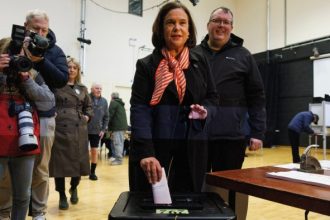By Dan Burns
NEW YORK (Reuters) – As 2024 comes into view, investors, economists, business leaders and everyday consumers from London to Lyons to Los Angeles share a common hope: Let the interest rate cuts begin!
Central banks from most major developed economies closed out 2023 with a blitz of policy meetings in December that effectively shut the books on the aggressive rate hikes that have dominated the economic and financial landscape since 2022. The lone outlier, the Bank of Japan (BOJ), never managed to kill off its negative rates policy and signaled this week at the year’s final meeting of a Group of Seven central banks that a shift away from that stance was not imminent.
Allowing the rest of the big central banks to call time on rate hikes was the favorable turn inflation took over the course of 2023. After starting the year with annual inflation rates that were on average 3.7 times the 2% target shared by the U.S. Federal Reserve, European Central Bank (ECB), Bank of England, Bank of Canada and BOJ, the pace of price increases is now down to 1.5 times that target.
Of course that means more work to do to complete the “last mile” in the inflation fight. Central bankers are loathe to declare victory prematurely and are battling with over-eager financial markets to retain maximum optionality, prompting the drum beat of pledges to hold rates high for a longer period or raise them again if necessary – the latter in particular being seen increasingly as an empty threat.
Inflation, however, does not need to drop all the way to 2% in order for rate cuts to begin, and 2-handle inflation rates could soon be the norm.
WHY IT MATTERS
Holding rates steady as inflation rates slow further is another form of policy tightening that may not be appropriate for much longer.
That is something some Fed officials have begun openly bandying about as a reason for the rate cuts they flagged last week as being in the cards next year, especially if they hope to deliver a “soft landing” for the U.S. economy.
Keeping rates restrictive for longer than necessary risks a harsher outcome, one featuring a rapid slowdown in economic activity, a painful rise in unemployment and a recession that much of the world has managed to dodge so far despite that scenario being the more traditional end to rate-hike cycles.
Rate-sensitive economic sectors everywhere – such as housing and manufacturing – have felt the pinch of higher rates for more than a year.
While services activity generally has continued to expand, S&P Global’s measure of manufacturing activity in developed economies has been in contraction since October 2022, although there are indications the worst may be over with the latest reading at the highest level since the spring. Emerging market factory output, which has been at stall speed for much of 2023, also edged higher.
WHAT IT MEANS FOR 2024
A major game of chicken is underway as market actors have set expectations for far more policy easing than central bankers are likely to be willing to provide.
For instance, while last week’s projections from Fed officials themselves indicated they expect 75 basis points of rate reductions over the course of 2024, bond and rate futures markets are now positioned for twice that amount. That led at least one U.S. central bank official, Chicago Fed President Austan Goolsbee, to confess that he was “confused” by the market’s behavior.
Across the Atlantic, meanwhile, sources familiar with the matter told Reuters it is unlikely that the ECB will be in position to cut rates before June, three months later than market pricing there now reflects.
The key to it all, of course, rests with inflation since policymakers have said they are willing to stomach some level of economic pain, if necessary, to finally return price pressures to their target levels.
Politics may play a hand as well, with general elections scheduled for later in the year, in the U.S and UK in particular. Central bankers who prize their political independence may not want to be seen taking major action too close to elections lest they be accused of trying to tip the outcome.
And as the year closed, a potential new spoiler was emerging that could complicate the rate-cut thesis: Attacks by Iran-backed Houthi rebels on cargo vessels in the Red Sea forced shippers to halt or reroute traffic, a supply chain hiccup that could impede further swift progress on inflation.
Read the full article here





